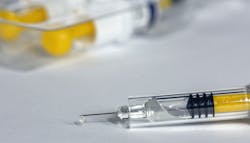President Franklin D. Roosevelt described Dec. 7, 1941, to an emergency Joint Session of Congress as “a date which will live on in infamy” following the horrendous attack on Pearl Harbor. Seventy-nine years and one day later, Dec. 8, 2020, made its mark in the history books as a 90-year-old grandmother in the United Kingdom (U.K.) became the first person in the world to receive the Pfizer/BioNTech vaccine to fight off COVID-19. Up to four million of her country men and women are expected to receive similar inoculations by the end of January. Meanwhile, on the same day, the U.S. Food and Drug Administration announced it determined the same vaccine has “met the prescribed success criteria,” a necessary precursor for the Pfizer/BioNTech vaccine to receive emergency use authorization in the U.S.
U.K. Secretary of of State for Health and Social Care Matt Hancock heralded the start of the vaccination program as “the start of the fightback against our common enemy, the coronavirus.” In many ways, it also marks the start of one of the supply chain’s greatest logistical challenges as a multitude of stakeholders work to ensure the safe and effective delivery of the vaccine to billions of people around the world.
You’ve heard the stories about the challenges of keeping some of the vaccines, including the Pfizer/BioNTech, at ultra-cold temperatures. The Pfizer/BioNTech must be stored long-term at minus 94 degrees Fahrenheit or below, a capability that even many of the most sophisticated health systems do not have. Another promising vaccine from Moderna also needs to be kept cold, but at less extreme temperatures, while others in the pipeline have even fewer requirements. None of this overcomes the fact that the different vaccines come with different requirements, from cold chain to the number of doses required, all of which introduces more variation into the system. And as readers of “Standard Practices” appreciate, variation is the enemy of quality.
Further, within days in November, we received two ominous warnings about cyber criminals attempting to disrupt the cold chain and render the vaccines ineffective, and the likelihood of organized crime stealing the highly valuable vaccines and/or selling fake doses.
The good news is we have the technology to overcome these challenges. The bad news is the use of that technology (e.g., bar codes and scanners) is limited, and the ability to share data across multiple parties, i.e., interoperability, remains a struggle. Couple that with the fact that the ability to secure vaccines through the system, whether to monitor the cold chain or to prevent counterfeit products, depends on the actions of a multitude of players, from manufacturers and distributors to hospitals and state and local health departments.
Let’s start with interoperability. We are making progress on the regulatory front, with new rules going into effect Jan. 1, 2021 that require hospitals and payers to share data across organizations and with patients. But hospitals, even before facing the challenges of COVID-19, have argued that compliance is difficult due to cost and technological capabilities.
The U.S. Drug Supply Chain Security Act (DSCSA) was passed in 2013 to help address the counterfeit issue, but all medicines are not required to be tracked at the unit level until 2023. The global standards organization, GS1, also has developed a data matrix configuration that can integrate the use of sensors to monitor temperature with bar codes, which would make it possible to address both the cold chain and counterfeit issues. At this point, there are no requirements to include bar codes at the primary (or vial) level. Instead, bar codes will be on the secondary packaging, which could hold hundreds of vaccines.
According to the World Health Organization, some manufacturers have argued that requiring bar codes at the primary packaging level would be both time consuming and costly, especially given that many sites where the vaccines will be given do not have the scanning capability in place. Others have countered that traceability of the vaccines will be much more difficult if those secondary packages need to be opened for distribution to rural and remote locations where there simply are not enough people to warrant sending the larger quantity packages. Instead, the ability to comply with cold chain requirements and to track which patients received which vaccine will be up to the individual players in the vaccine supply chain. The vials will have information that can be recorded manually, but as we all know, manual documentation is error prone.
How then can we be confident that we are capturing information accurately to ensure the effectiveness of the vaccines by complying with cold chain requirements; monitor for potential adverse effects of any of the vaccines or specific batches or lots; and guarantee that patients who require a second dose do indeed get the second dose of the same vaccine? These are all critical issues to achieve the promise of what has been nothing short of a modern medical miracle around the speed of vaccine development. As a friend of mine in the vaccine manufacturing space asked: If we can create effective vaccines in less than a year, why can’t we take the time to ensure the integrity of the vaccines by applying barcodes to support traceability?
About the Author

Karen Conway
CEO, Value Works
Karen Conway, CEO, ValueWorks
Karen Conway applies her knowledge of supply chain operations and systems thinking to align data and processes to improve health outcomes and the performance of organizations upon which an effective healthcare system depends. After retiring in 2024 from GHX, where she served as Vice President of Healthcare Value, Conway established ValueWorks to advance the role of supply chain to achieve a value-based healthcare system that optimizes the cost and quality of care, while improving both equity and sustainability in care delivery. Conway is former national chair of AHRMM, the supply chain association for the American Hospital Association, and an honorary member of the Health Care Supplies Association in the UK.
